Management Accounting: Systems, Reports, Costing, and Budgetary Tools
VerifiedAdded on 2020/07/23
|14
|3737
|43
Report
AI Summary
This report provides a comprehensive overview of management accounting, encompassing its systems, reports, and various costing methods. It begins by defining management accounting and its importance in organizational decision-making, emphasizing its distinction from financial accounting. The report then delves into the core components of management accounting systems, including cost accounting, inventory management, and value estimation frameworks. It explores different types of management accounting reports, such as performance reports, financial reports, and inventory management reports, highlighting their roles in evaluation, financial analysis, and operational control. Furthermore, the report offers a detailed comparison of marginal and absorption costing techniques, elucidating their applications in cost calculation and profit analysis. The report also examines budgetary tools and techniques to improve final outputs. Overall, the report aims to enhance the reader's understanding of management accounting principles and their practical applications in achieving organizational goals and objectives.
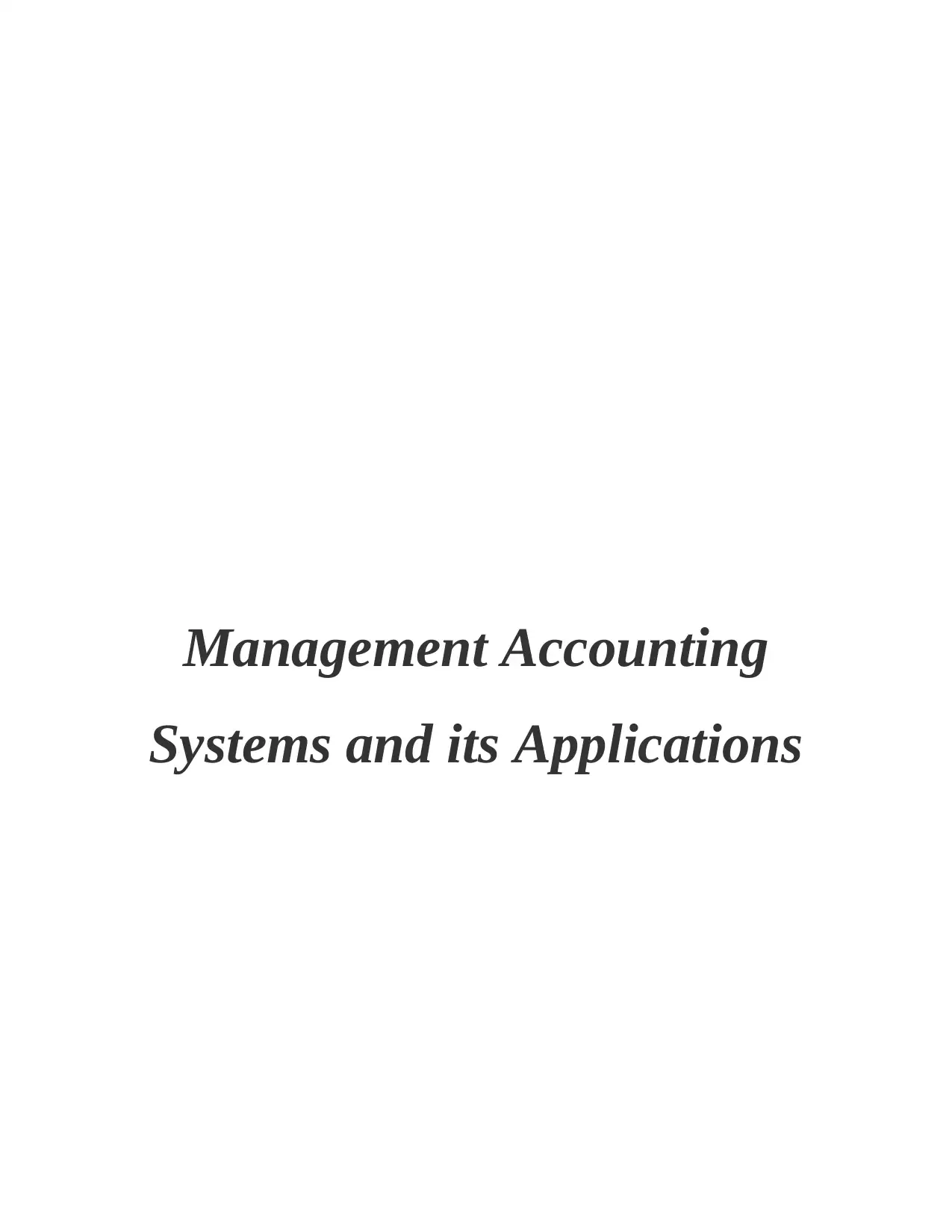
Management Accounting
Systems and its Applications
Systems and its Applications
Paraphrase This Document
Need a fresh take? Get an instant paraphrase of this document with our AI Paraphraser
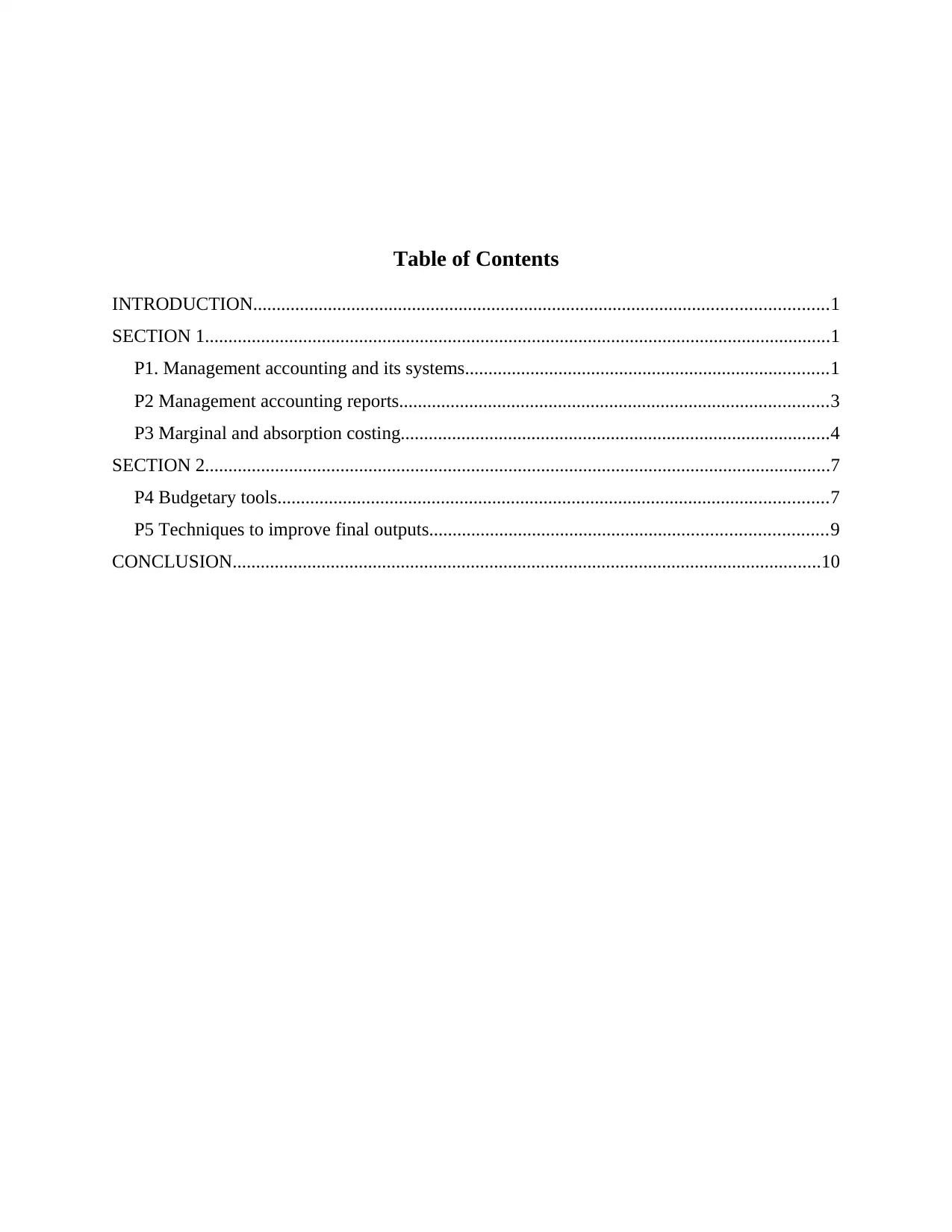
Table of Contents
INTRODUCTION...........................................................................................................................1
SECTION 1......................................................................................................................................1
P1. Management accounting and its systems..............................................................................1
P2 Management accounting reports............................................................................................3
P3 Marginal and absorption costing............................................................................................4
SECTION 2......................................................................................................................................7
P4 Budgetary tools......................................................................................................................7
P5 Techniques to improve final outputs.....................................................................................9
CONCLUSION..............................................................................................................................10
INTRODUCTION...........................................................................................................................1
SECTION 1......................................................................................................................................1
P1. Management accounting and its systems..............................................................................1
P2 Management accounting reports............................................................................................3
P3 Marginal and absorption costing............................................................................................4
SECTION 2......................................................................................................................................7
P4 Budgetary tools......................................................................................................................7
P5 Techniques to improve final outputs.....................................................................................9
CONCLUSION..............................................................................................................................10
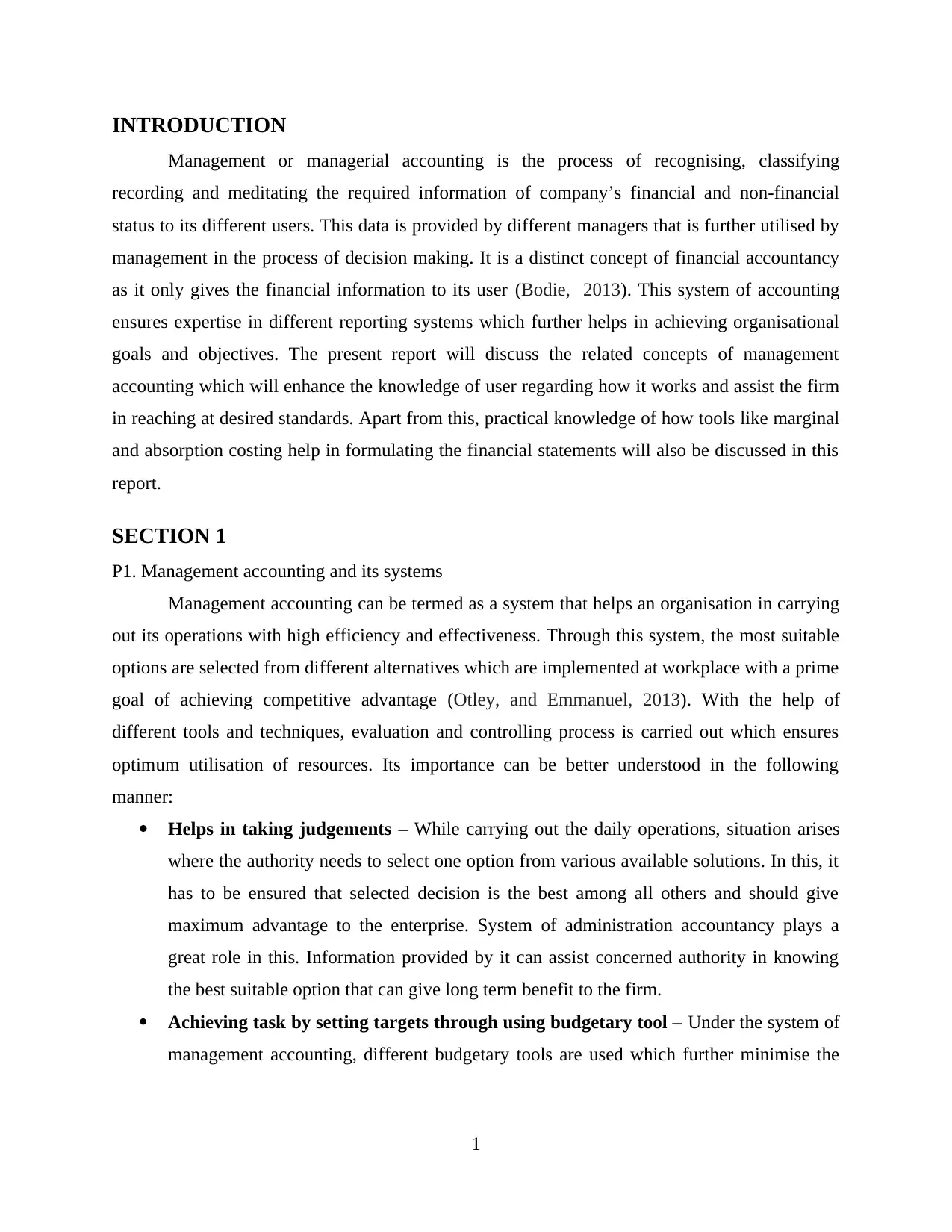
INTRODUCTION
Management or managerial accounting is the process of recognising, classifying
recording and meditating the required information of company’s financial and non-financial
status to its different users. This data is provided by different managers that is further utilised by
management in the process of decision making. It is a distinct concept of financial accountancy
as it only gives the financial information to its user (Bodie, 2013). This system of accounting
ensures expertise in different reporting systems which further helps in achieving organisational
goals and objectives. The present report will discuss the related concepts of management
accounting which will enhance the knowledge of user regarding how it works and assist the firm
in reaching at desired standards. Apart from this, practical knowledge of how tools like marginal
and absorption costing help in formulating the financial statements will also be discussed in this
report.
SECTION 1
P1. Management accounting and its systems
Management accounting can be termed as a system that helps an organisation in carrying
out its operations with high efficiency and effectiveness. Through this system, the most suitable
options are selected from different alternatives which are implemented at workplace with a prime
goal of achieving competitive advantage (Otley, and Emmanuel, 2013). With the help of
different tools and techniques, evaluation and controlling process is carried out which ensures
optimum utilisation of resources. Its importance can be better understood in the following
manner:
Helps in taking judgements – While carrying out the daily operations, situation arises
where the authority needs to select one option from various available solutions. In this, it
has to be ensured that selected decision is the best among all others and should give
maximum advantage to the enterprise. System of administration accountancy plays a
great role in this. Information provided by it can assist concerned authority in knowing
the best suitable option that can give long term benefit to the firm.
Achieving task by setting targets through using budgetary tool – Under the system of
management accounting, different budgetary tools are used which further minimise the
1
Management or managerial accounting is the process of recognising, classifying
recording and meditating the required information of company’s financial and non-financial
status to its different users. This data is provided by different managers that is further utilised by
management in the process of decision making. It is a distinct concept of financial accountancy
as it only gives the financial information to its user (Bodie, 2013). This system of accounting
ensures expertise in different reporting systems which further helps in achieving organisational
goals and objectives. The present report will discuss the related concepts of management
accounting which will enhance the knowledge of user regarding how it works and assist the firm
in reaching at desired standards. Apart from this, practical knowledge of how tools like marginal
and absorption costing help in formulating the financial statements will also be discussed in this
report.
SECTION 1
P1. Management accounting and its systems
Management accounting can be termed as a system that helps an organisation in carrying
out its operations with high efficiency and effectiveness. Through this system, the most suitable
options are selected from different alternatives which are implemented at workplace with a prime
goal of achieving competitive advantage (Otley, and Emmanuel, 2013). With the help of
different tools and techniques, evaluation and controlling process is carried out which ensures
optimum utilisation of resources. Its importance can be better understood in the following
manner:
Helps in taking judgements – While carrying out the daily operations, situation arises
where the authority needs to select one option from various available solutions. In this, it
has to be ensured that selected decision is the best among all others and should give
maximum advantage to the enterprise. System of administration accountancy plays a
great role in this. Information provided by it can assist concerned authority in knowing
the best suitable option that can give long term benefit to the firm.
Achieving task by setting targets through using budgetary tool – Under the system of
management accounting, different budgetary tools are used which further minimise the
1
⊘ This is a preview!⊘
Do you want full access?
Subscribe today to unlock all pages.

Trusted by 1+ million students worldwide
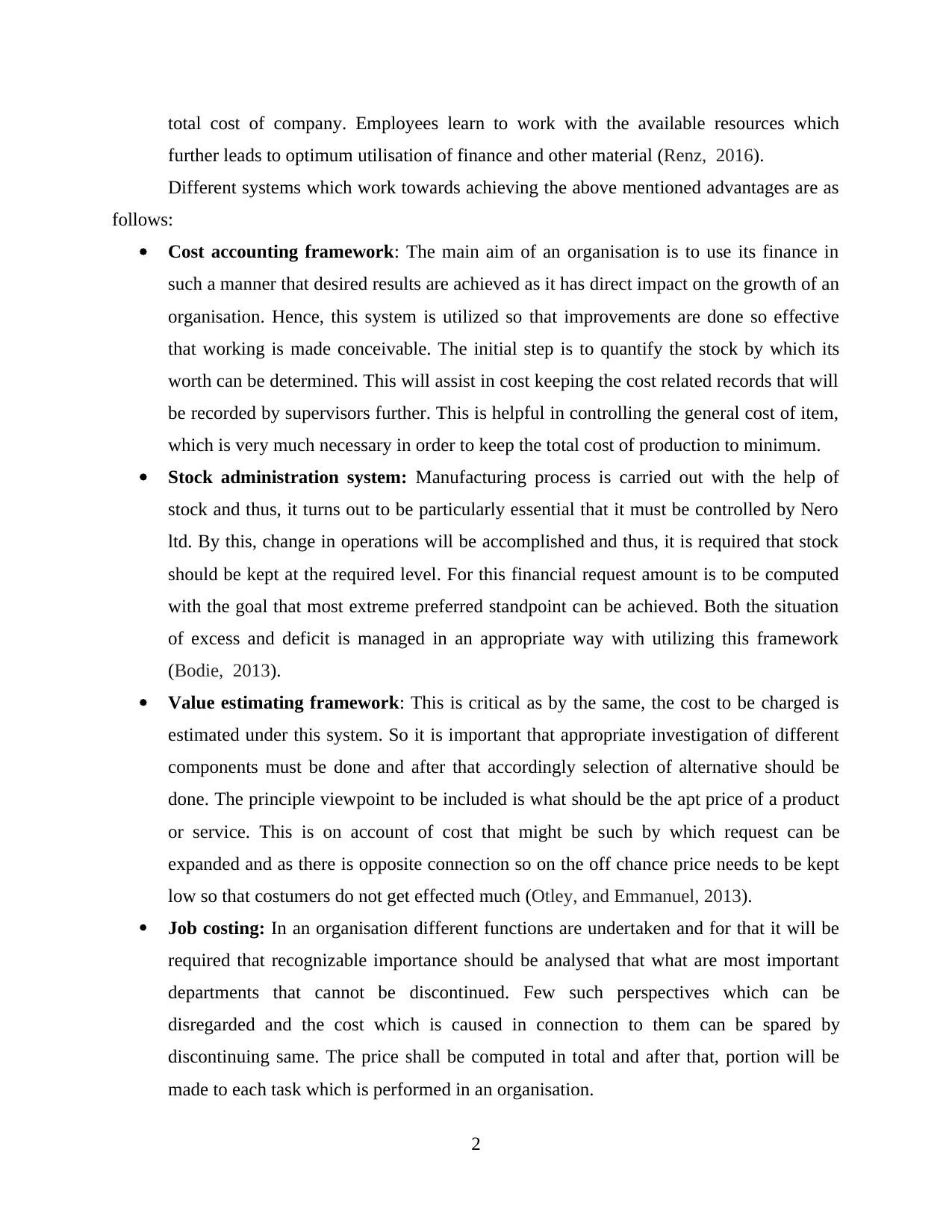
total cost of company. Employees learn to work with the available resources which
further leads to optimum utilisation of finance and other material (Renz, 2016).
Different systems which work towards achieving the above mentioned advantages are as
follows:
Cost accounting framework: The main aim of an organisation is to use its finance in
such a manner that desired results are achieved as it has direct impact on the growth of an
organisation. Hence, this system is utilized so that improvements are done so effective
that working is made conceivable. The initial step is to quantify the stock by which its
worth can be determined. This will assist in cost keeping the cost related records that will
be recorded by supervisors further. This is helpful in controlling the general cost of item,
which is very much necessary in order to keep the total cost of production to minimum.
Stock administration system: Manufacturing process is carried out with the help of
stock and thus, it turns out to be particularly essential that it must be controlled by Nero
ltd. By this, change in operations will be accomplished and thus, it is required that stock
should be kept at the required level. For this financial request amount is to be computed
with the goal that most extreme preferred standpoint can be achieved. Both the situation
of excess and deficit is managed in an appropriate way with utilizing this framework
(Bodie, 2013).
Value estimating framework: This is critical as by the same, the cost to be charged is
estimated under this system. So it is important that appropriate investigation of different
components must be done and after that accordingly selection of alternative should be
done. The principle viewpoint to be included is what should be the apt price of a product
or service. This is on account of cost that might be such by which request can be
expanded and as there is opposite connection so on the off chance price needs to be kept
low so that costumers do not get effected much (Otley, and Emmanuel, 2013).
Job costing: In an organisation different functions are undertaken and for that it will be
required that recognizable importance should be analysed that what are most important
departments that cannot be discontinued. Few such perspectives which can be
disregarded and the cost which is caused in connection to them can be spared by
discontinuing same. The price shall be computed in total and after that, portion will be
made to each task which is performed in an organisation.
2
further leads to optimum utilisation of finance and other material (Renz, 2016).
Different systems which work towards achieving the above mentioned advantages are as
follows:
Cost accounting framework: The main aim of an organisation is to use its finance in
such a manner that desired results are achieved as it has direct impact on the growth of an
organisation. Hence, this system is utilized so that improvements are done so effective
that working is made conceivable. The initial step is to quantify the stock by which its
worth can be determined. This will assist in cost keeping the cost related records that will
be recorded by supervisors further. This is helpful in controlling the general cost of item,
which is very much necessary in order to keep the total cost of production to minimum.
Stock administration system: Manufacturing process is carried out with the help of
stock and thus, it turns out to be particularly essential that it must be controlled by Nero
ltd. By this, change in operations will be accomplished and thus, it is required that stock
should be kept at the required level. For this financial request amount is to be computed
with the goal that most extreme preferred standpoint can be achieved. Both the situation
of excess and deficit is managed in an appropriate way with utilizing this framework
(Bodie, 2013).
Value estimating framework: This is critical as by the same, the cost to be charged is
estimated under this system. So it is important that appropriate investigation of different
components must be done and after that accordingly selection of alternative should be
done. The principle viewpoint to be included is what should be the apt price of a product
or service. This is on account of cost that might be such by which request can be
expanded and as there is opposite connection so on the off chance price needs to be kept
low so that costumers do not get effected much (Otley, and Emmanuel, 2013).
Job costing: In an organisation different functions are undertaken and for that it will be
required that recognizable importance should be analysed that what are most important
departments that cannot be discontinued. Few such perspectives which can be
disregarded and the cost which is caused in connection to them can be spared by
discontinuing same. The price shall be computed in total and after that, portion will be
made to each task which is performed in an organisation.
2
Paraphrase This Document
Need a fresh take? Get an instant paraphrase of this document with our AI Paraphraser
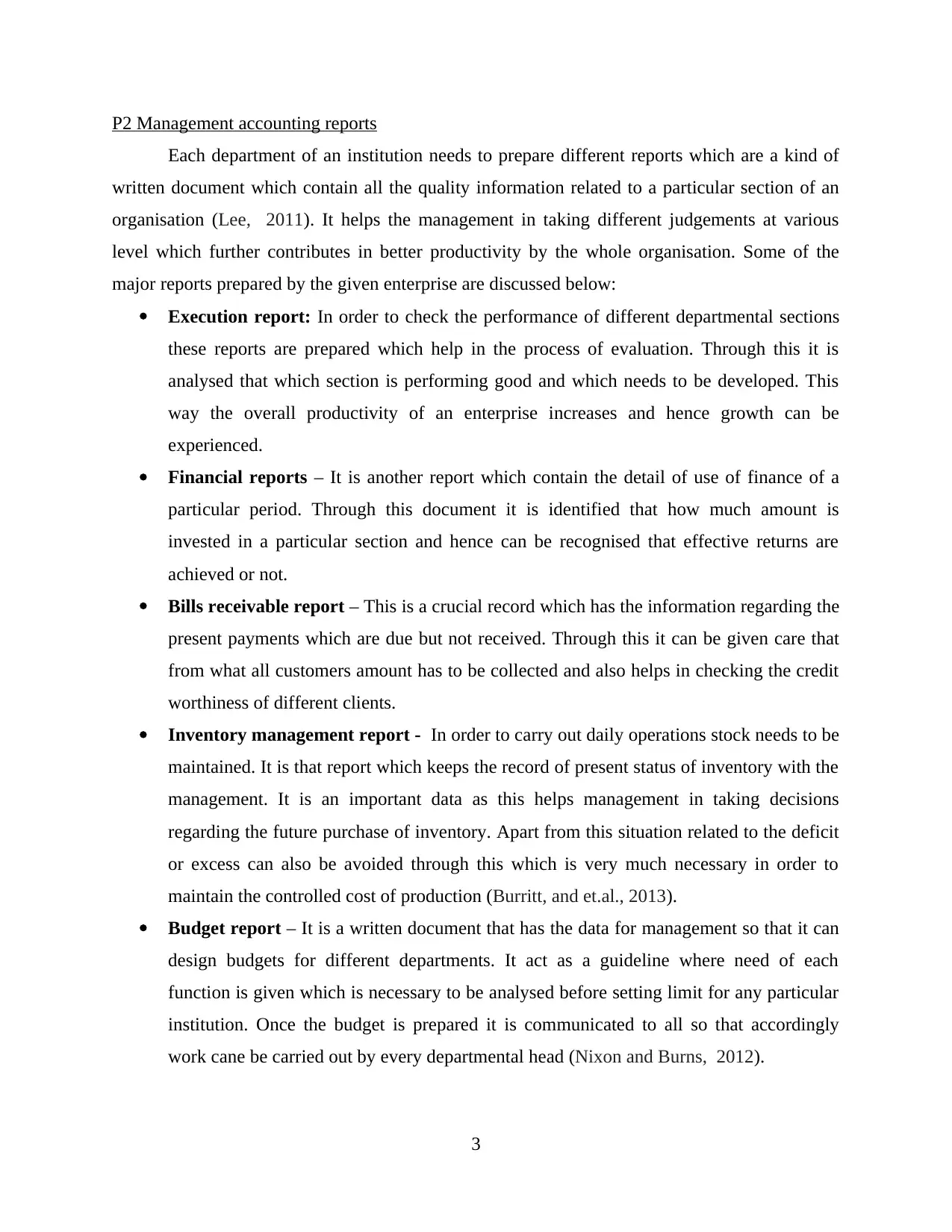
P2 Management accounting reports
Each department of an institution needs to prepare different reports which are a kind of
written document which contain all the quality information related to a particular section of an
organisation (Lee, 2011). It helps the management in taking different judgements at various
level which further contributes in better productivity by the whole organisation. Some of the
major reports prepared by the given enterprise are discussed below:
Execution report: In order to check the performance of different departmental sections
these reports are prepared which help in the process of evaluation. Through this it is
analysed that which section is performing good and which needs to be developed. This
way the overall productivity of an enterprise increases and hence growth can be
experienced.
Financial reports – It is another report which contain the detail of use of finance of a
particular period. Through this document it is identified that how much amount is
invested in a particular section and hence can be recognised that effective returns are
achieved or not.
Bills receivable report – This is a crucial record which has the information regarding the
present payments which are due but not received. Through this it can be given care that
from what all customers amount has to be collected and also helps in checking the credit
worthiness of different clients.
Inventory management report - In order to carry out daily operations stock needs to be
maintained. It is that report which keeps the record of present status of inventory with the
management. It is an important data as this helps management in taking decisions
regarding the future purchase of inventory. Apart from this situation related to the deficit
or excess can also be avoided through this which is very much necessary in order to
maintain the controlled cost of production (Burritt, and et.al., 2013).
Budget report – It is a written document that has the data for management so that it can
design budgets for different departments. It act as a guideline where need of each
function is given which is necessary to be analysed before setting limit for any particular
institution. Once the budget is prepared it is communicated to all so that accordingly
work cane be carried out by every departmental head (Nixon and Burns, 2012).
3
Each department of an institution needs to prepare different reports which are a kind of
written document which contain all the quality information related to a particular section of an
organisation (Lee, 2011). It helps the management in taking different judgements at various
level which further contributes in better productivity by the whole organisation. Some of the
major reports prepared by the given enterprise are discussed below:
Execution report: In order to check the performance of different departmental sections
these reports are prepared which help in the process of evaluation. Through this it is
analysed that which section is performing good and which needs to be developed. This
way the overall productivity of an enterprise increases and hence growth can be
experienced.
Financial reports – It is another report which contain the detail of use of finance of a
particular period. Through this document it is identified that how much amount is
invested in a particular section and hence can be recognised that effective returns are
achieved or not.
Bills receivable report – This is a crucial record which has the information regarding the
present payments which are due but not received. Through this it can be given care that
from what all customers amount has to be collected and also helps in checking the credit
worthiness of different clients.
Inventory management report - In order to carry out daily operations stock needs to be
maintained. It is that report which keeps the record of present status of inventory with the
management. It is an important data as this helps management in taking decisions
regarding the future purchase of inventory. Apart from this situation related to the deficit
or excess can also be avoided through this which is very much necessary in order to
maintain the controlled cost of production (Burritt, and et.al., 2013).
Budget report – It is a written document that has the data for management so that it can
design budgets for different departments. It act as a guideline where need of each
function is given which is necessary to be analysed before setting limit for any particular
institution. Once the budget is prepared it is communicated to all so that accordingly
work cane be carried out by every departmental head (Nixon and Burns, 2012).
3
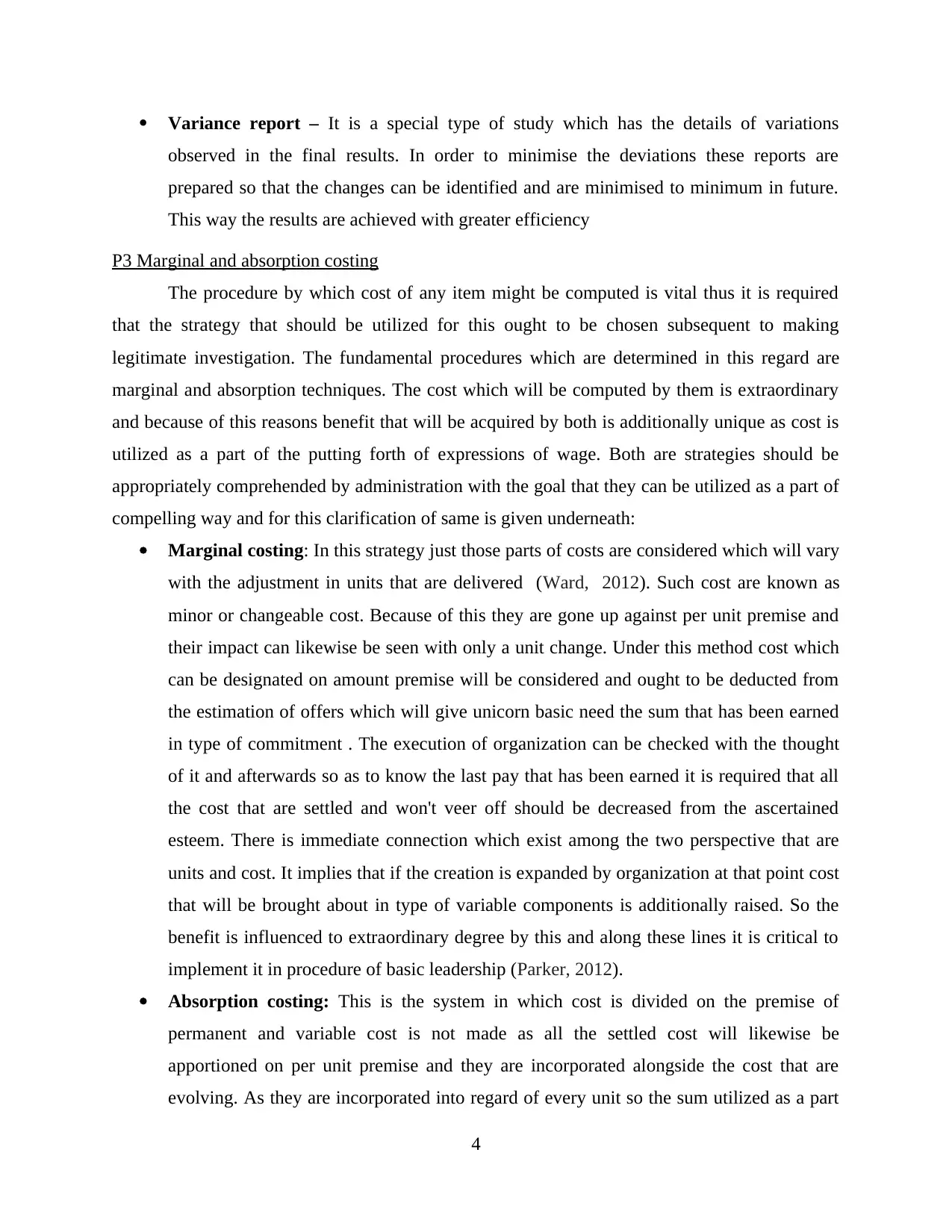
Variance report – It is a special type of study which has the details of variations
observed in the final results. In order to minimise the deviations these reports are
prepared so that the changes can be identified and are minimised to minimum in future.
This way the results are achieved with greater efficiency
P3 Marginal and absorption costing
The procedure by which cost of any item might be computed is vital thus it is required
that the strategy that should be utilized for this ought to be chosen subsequent to making
legitimate investigation. The fundamental procedures which are determined in this regard are
marginal and absorption techniques. The cost which will be computed by them is extraordinary
and because of this reasons benefit that will be acquired by both is additionally unique as cost is
utilized as a part of the putting forth of expressions of wage. Both are strategies should be
appropriately comprehended by administration with the goal that they can be utilized as a part of
compelling way and for this clarification of same is given underneath:
Marginal costing: In this strategy just those parts of costs are considered which will vary
with the adjustment in units that are delivered (Ward, 2012). Such cost are known as
minor or changeable cost. Because of this they are gone up against per unit premise and
their impact can likewise be seen with only a unit change. Under this method cost which
can be designated on amount premise will be considered and ought to be deducted from
the estimation of offers which will give unicorn basic need the sum that has been earned
in type of commitment . The execution of organization can be checked with the thought
of it and afterwards so as to know the last pay that has been earned it is required that all
the cost that are settled and won't veer off should be decreased from the ascertained
esteem. There is immediate connection which exist among the two perspective that are
units and cost. It implies that if the creation is expanded by organization at that point cost
that will be brought about in type of variable components is additionally raised. So the
benefit is influenced to extraordinary degree by this and along these lines it is critical to
implement it in procedure of basic leadership (Parker, 2012).
Absorption costing: This is the system in which cost is divided on the premise of
permanent and variable cost is not made as all the settled cost will likewise be
apportioned on per unit premise and they are incorporated alongside the cost that are
evolving. As they are incorporated into regard of every unit so the sum utilized as a part
4
observed in the final results. In order to minimise the deviations these reports are
prepared so that the changes can be identified and are minimised to minimum in future.
This way the results are achieved with greater efficiency
P3 Marginal and absorption costing
The procedure by which cost of any item might be computed is vital thus it is required
that the strategy that should be utilized for this ought to be chosen subsequent to making
legitimate investigation. The fundamental procedures which are determined in this regard are
marginal and absorption techniques. The cost which will be computed by them is extraordinary
and because of this reasons benefit that will be acquired by both is additionally unique as cost is
utilized as a part of the putting forth of expressions of wage. Both are strategies should be
appropriately comprehended by administration with the goal that they can be utilized as a part of
compelling way and for this clarification of same is given underneath:
Marginal costing: In this strategy just those parts of costs are considered which will vary
with the adjustment in units that are delivered (Ward, 2012). Such cost are known as
minor or changeable cost. Because of this they are gone up against per unit premise and
their impact can likewise be seen with only a unit change. Under this method cost which
can be designated on amount premise will be considered and ought to be deducted from
the estimation of offers which will give unicorn basic need the sum that has been earned
in type of commitment . The execution of organization can be checked with the thought
of it and afterwards so as to know the last pay that has been earned it is required that all
the cost that are settled and won't veer off should be decreased from the ascertained
esteem. There is immediate connection which exist among the two perspective that are
units and cost. It implies that if the creation is expanded by organization at that point cost
that will be brought about in type of variable components is additionally raised. So the
benefit is influenced to extraordinary degree by this and along these lines it is critical to
implement it in procedure of basic leadership (Parker, 2012).
Absorption costing: This is the system in which cost is divided on the premise of
permanent and variable cost is not made as all the settled cost will likewise be
apportioned on per unit premise and they are incorporated alongside the cost that are
evolving. As they are incorporated into regard of every unit so the sum utilized as a part
4
⊘ This is a preview!⊘
Do you want full access?
Subscribe today to unlock all pages.

Trusted by 1+ million students worldwide
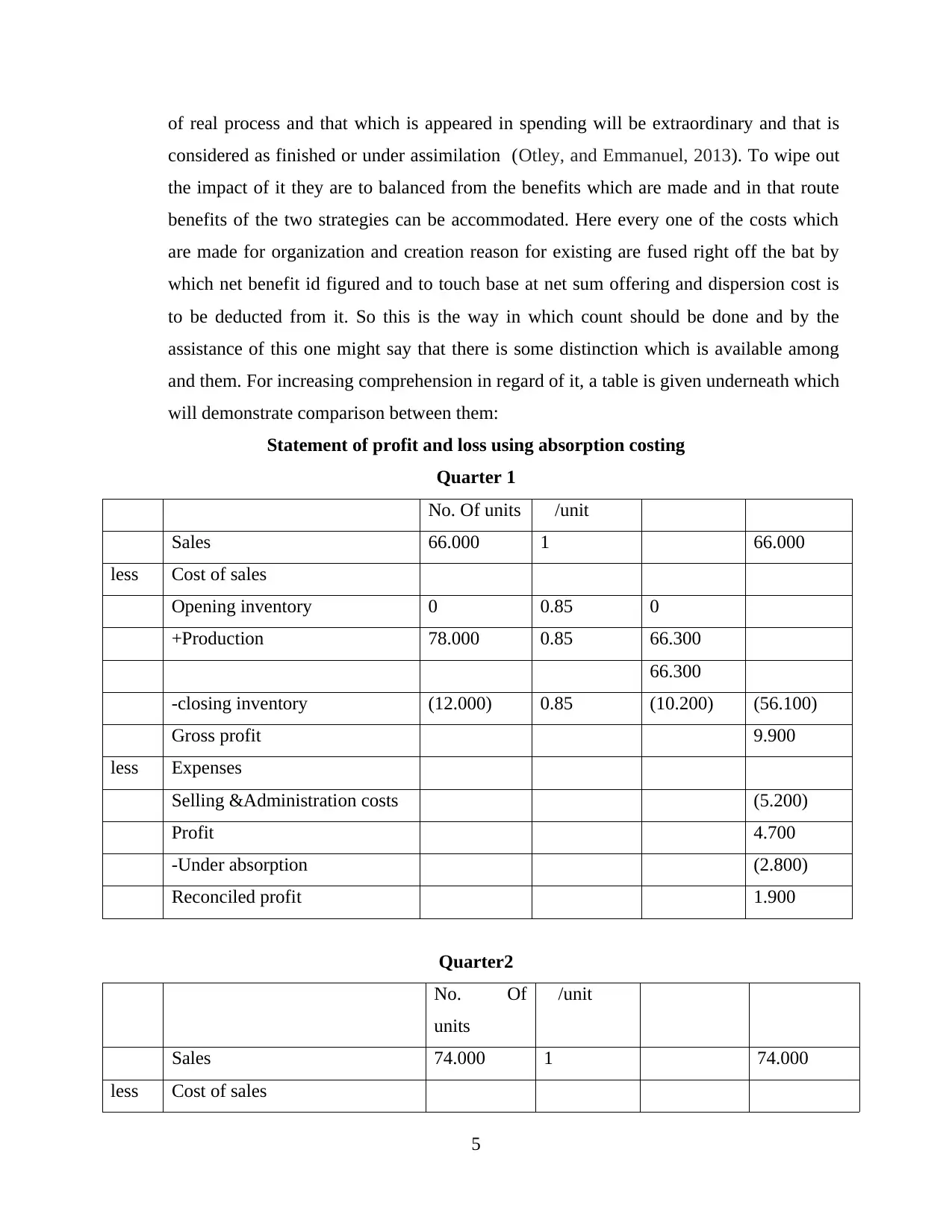
of real process and that which is appeared in spending will be extraordinary and that is
considered as finished or under assimilation (Otley, and Emmanuel, 2013). To wipe out
the impact of it they are to balanced from the benefits which are made and in that route
benefits of the two strategies can be accommodated. Here every one of the costs which
are made for organization and creation reason for existing are fused right off the bat by
which net benefit id figured and to touch base at net sum offering and dispersion cost is
to be deducted from it. So this is the way in which count should be done and by the
assistance of this one might say that there is some distinction which is available among
and them. For increasing comprehension in regard of it, a table is given underneath which
will demonstrate comparison between them:
Statement of profit and loss using absorption costing
Quarter 1
No. Of units £/unit £ £
Sales 66.000 1 66.000
less Cost of sales
Opening inventory 0 0.85 0
+Production 78.000 0.85 66.300
66.300
-closing inventory (12.000) 0.85 (10.200) (56.100)
Gross profit 9.900
less Expenses
Selling &Administration costs (5.200)
Profit 4.700
-Under absorption (2.800)
Reconciled profit 1.900
Quarter2
No. Of
units
£/unit £ £
Sales 74.000 1 74.000
less Cost of sales
5
considered as finished or under assimilation (Otley, and Emmanuel, 2013). To wipe out
the impact of it they are to balanced from the benefits which are made and in that route
benefits of the two strategies can be accommodated. Here every one of the costs which
are made for organization and creation reason for existing are fused right off the bat by
which net benefit id figured and to touch base at net sum offering and dispersion cost is
to be deducted from it. So this is the way in which count should be done and by the
assistance of this one might say that there is some distinction which is available among
and them. For increasing comprehension in regard of it, a table is given underneath which
will demonstrate comparison between them:
Statement of profit and loss using absorption costing
Quarter 1
No. Of units £/unit £ £
Sales 66.000 1 66.000
less Cost of sales
Opening inventory 0 0.85 0
+Production 78.000 0.85 66.300
66.300
-closing inventory (12.000) 0.85 (10.200) (56.100)
Gross profit 9.900
less Expenses
Selling &Administration costs (5.200)
Profit 4.700
-Under absorption (2.800)
Reconciled profit 1.900
Quarter2
No. Of
units
£/unit £ £
Sales 74.000 1 74.000
less Cost of sales
5
Paraphrase This Document
Need a fresh take? Get an instant paraphrase of this document with our AI Paraphraser
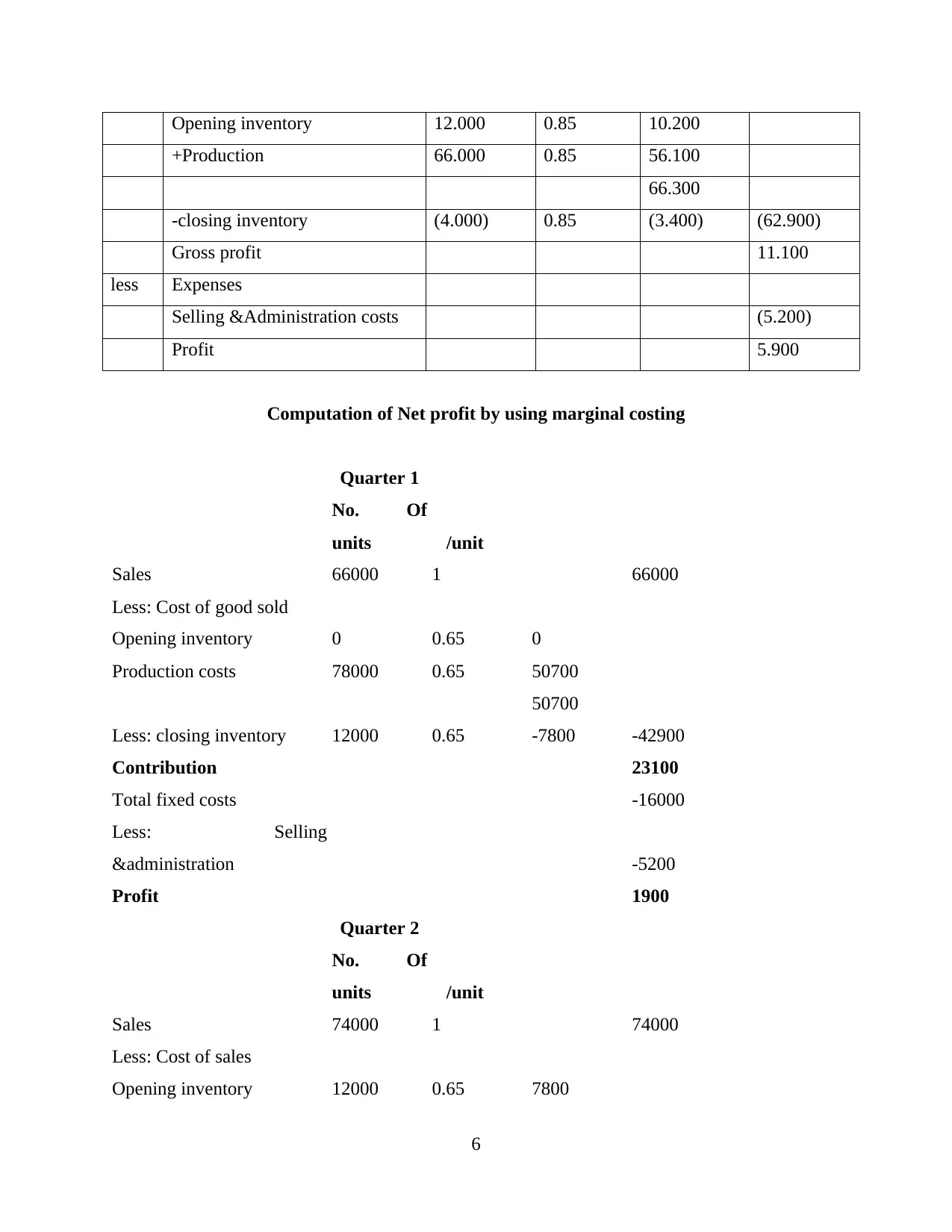
Opening inventory 12.000 0.85 10.200
+Production 66.000 0.85 56.100
66.300
-closing inventory (4.000) 0.85 (3.400) (62.900)
Gross profit 11.100
less Expenses
Selling &Administration costs (5.200)
Profit 5.900
Computation of Net profit by using marginal costing
Quarter 1
No. Of
units £/unit £ £
Sales 66000 1 66000
Less: Cost of good sold
Opening inventory 0 0.65 0
Production costs 78000 0.65 50700
50700
Less: closing inventory 12000 0.65 -7800 -42900
Contribution 23100
Total fixed costs -16000
Less: Selling
&administration -5200
Profit 1900
Quarter 2
No. Of
units £/unit £ £
Sales 74000 1 74000
Less: Cost of sales
Opening inventory 12000 0.65 7800
6
+Production 66.000 0.85 56.100
66.300
-closing inventory (4.000) 0.85 (3.400) (62.900)
Gross profit 11.100
less Expenses
Selling &Administration costs (5.200)
Profit 5.900
Computation of Net profit by using marginal costing
Quarter 1
No. Of
units £/unit £ £
Sales 66000 1 66000
Less: Cost of good sold
Opening inventory 0 0.65 0
Production costs 78000 0.65 50700
50700
Less: closing inventory 12000 0.65 -7800 -42900
Contribution 23100
Total fixed costs -16000
Less: Selling
&administration -5200
Profit 1900
Quarter 2
No. Of
units £/unit £ £
Sales 74000 1 74000
Less: Cost of sales
Opening inventory 12000 0.65 7800
6
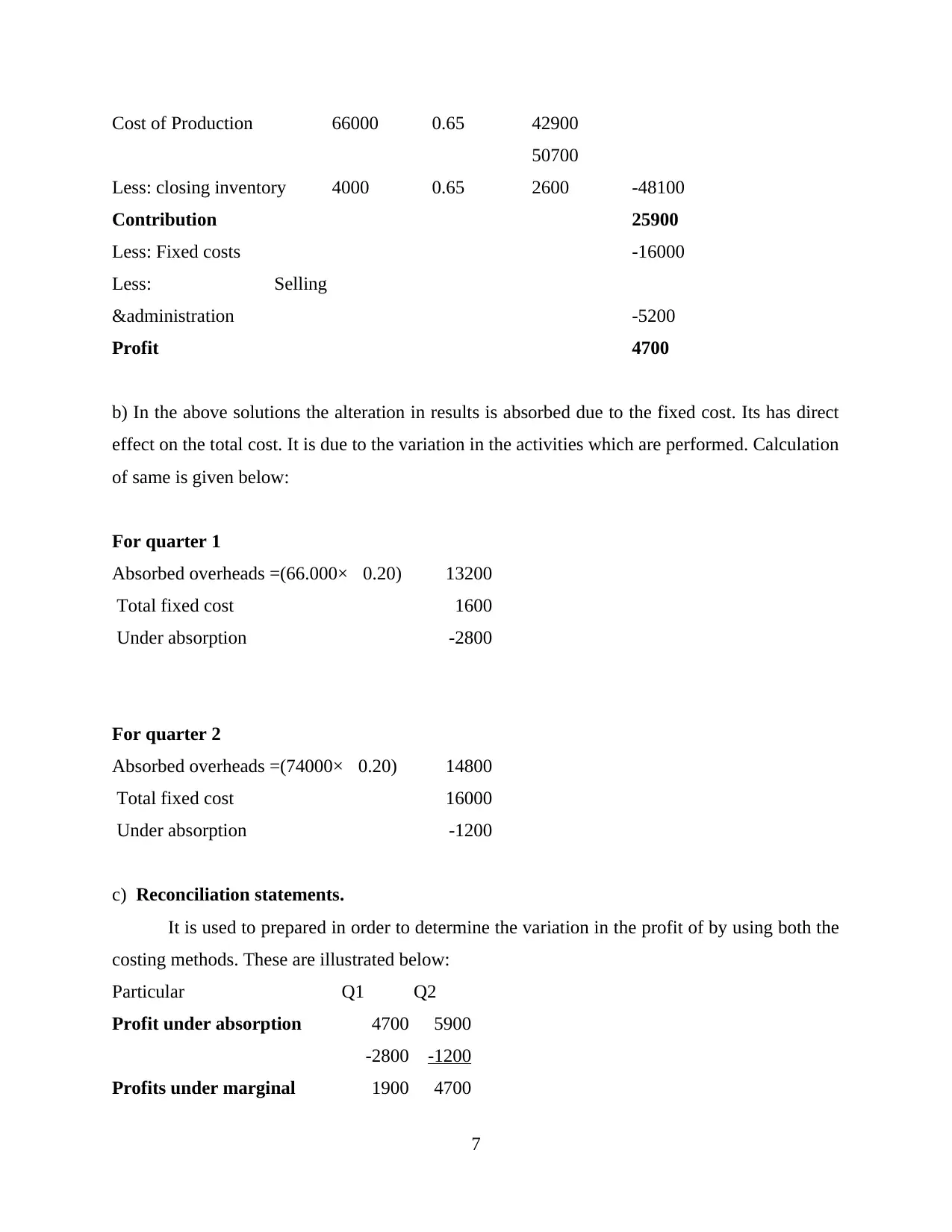
Cost of Production 66000 0.65 42900
50700
Less: closing inventory 4000 0.65 2600 -48100
Contribution 25900
Less: Fixed costs -16000
Less: Selling
&administration -5200
Profit 4700
b) In the above solutions the alteration in results is absorbed due to the fixed cost. Its has direct
effect on the total cost. It is due to the variation in the activities which are performed. Calculation
of same is given below:
For quarter 1
Absorbed overheads =(66.000×£0.20) 13200
Total fixed cost 1600
Under absorption -2800
For quarter 2
Absorbed overheads =(74000×£0.20) 14800
Total fixed cost 16000
Under absorption -1200
c) Reconciliation statements.
It is used to prepared in order to determine the variation in the profit of by using both the
costing methods. These are illustrated below:
Particular Q1 Q2
Profit under absorption 4700 5900
-2800 -1200
Profits under marginal 1900 4700
7
50700
Less: closing inventory 4000 0.65 2600 -48100
Contribution 25900
Less: Fixed costs -16000
Less: Selling
&administration -5200
Profit 4700
b) In the above solutions the alteration in results is absorbed due to the fixed cost. Its has direct
effect on the total cost. It is due to the variation in the activities which are performed. Calculation
of same is given below:
For quarter 1
Absorbed overheads =(66.000×£0.20) 13200
Total fixed cost 1600
Under absorption -2800
For quarter 2
Absorbed overheads =(74000×£0.20) 14800
Total fixed cost 16000
Under absorption -1200
c) Reconciliation statements.
It is used to prepared in order to determine the variation in the profit of by using both the
costing methods. These are illustrated below:
Particular Q1 Q2
Profit under absorption 4700 5900
-2800 -1200
Profits under marginal 1900 4700
7
⊘ This is a preview!⊘
Do you want full access?
Subscribe today to unlock all pages.

Trusted by 1+ million students worldwide
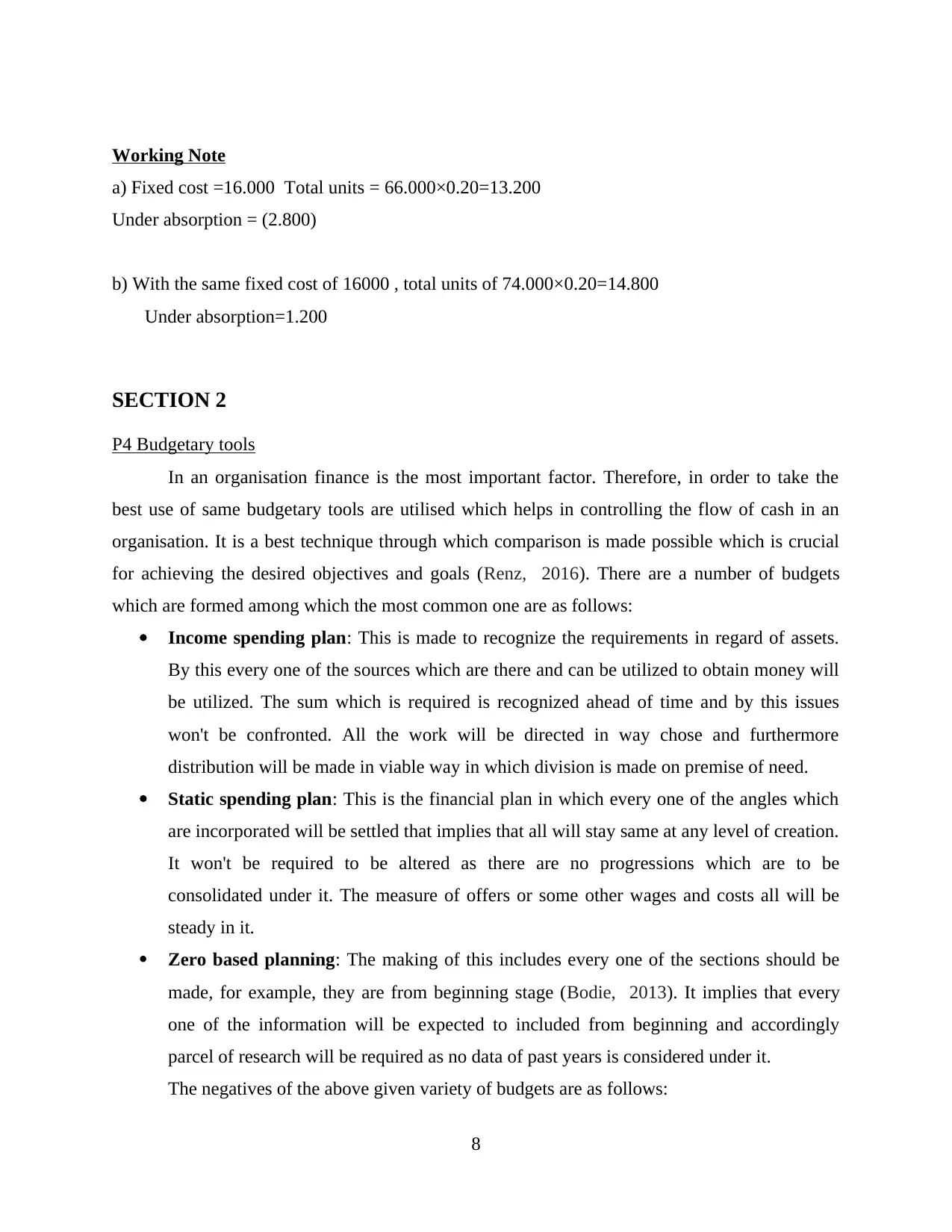
Working Note
a) Fixed cost =16.000 Total units = 66.000×0.20=13.200
Under absorption = (2.800)
b) With the same fixed cost of 16000 , total units of 74.000×0.20=14.800
Under absorption=1.200
SECTION 2
P4 Budgetary tools
In an organisation finance is the most important factor. Therefore, in order to take the
best use of same budgetary tools are utilised which helps in controlling the flow of cash in an
organisation. It is a best technique through which comparison is made possible which is crucial
for achieving the desired objectives and goals (Renz, 2016). There are a number of budgets
which are formed among which the most common one are as follows:
Income spending plan: This is made to recognize the requirements in regard of assets.
By this every one of the sources which are there and can be utilized to obtain money will
be utilized. The sum which is required is recognized ahead of time and by this issues
won't be confronted. All the work will be directed in way chose and furthermore
distribution will be made in viable way in which division is made on premise of need.
Static spending plan: This is the financial plan in which every one of the angles which
are incorporated will be settled that implies that all will stay same at any level of creation.
It won't be required to be altered as there are no progressions which are to be
consolidated under it. The measure of offers or some other wages and costs all will be
steady in it.
Zero based planning: The making of this includes every one of the sections should be
made, for example, they are from beginning stage (Bodie, 2013). It implies that every
one of the information will be expected to included from beginning and accordingly
parcel of research will be required as no data of past years is considered under it.
The negatives of the above given variety of budgets are as follows:
8
a) Fixed cost =16.000 Total units = 66.000×0.20=13.200
Under absorption = (2.800)
b) With the same fixed cost of 16000 , total units of 74.000×0.20=14.800
Under absorption=1.200
SECTION 2
P4 Budgetary tools
In an organisation finance is the most important factor. Therefore, in order to take the
best use of same budgetary tools are utilised which helps in controlling the flow of cash in an
organisation. It is a best technique through which comparison is made possible which is crucial
for achieving the desired objectives and goals (Renz, 2016). There are a number of budgets
which are formed among which the most common one are as follows:
Income spending plan: This is made to recognize the requirements in regard of assets.
By this every one of the sources which are there and can be utilized to obtain money will
be utilized. The sum which is required is recognized ahead of time and by this issues
won't be confronted. All the work will be directed in way chose and furthermore
distribution will be made in viable way in which division is made on premise of need.
Static spending plan: This is the financial plan in which every one of the angles which
are incorporated will be settled that implies that all will stay same at any level of creation.
It won't be required to be altered as there are no progressions which are to be
consolidated under it. The measure of offers or some other wages and costs all will be
steady in it.
Zero based planning: The making of this includes every one of the sections should be
made, for example, they are from beginning stage (Bodie, 2013). It implies that every
one of the information will be expected to included from beginning and accordingly
parcel of research will be required as no data of past years is considered under it.
The negatives of the above given variety of budgets are as follows:
8
Paraphrase This Document
Need a fresh take? Get an instant paraphrase of this document with our AI Paraphraser
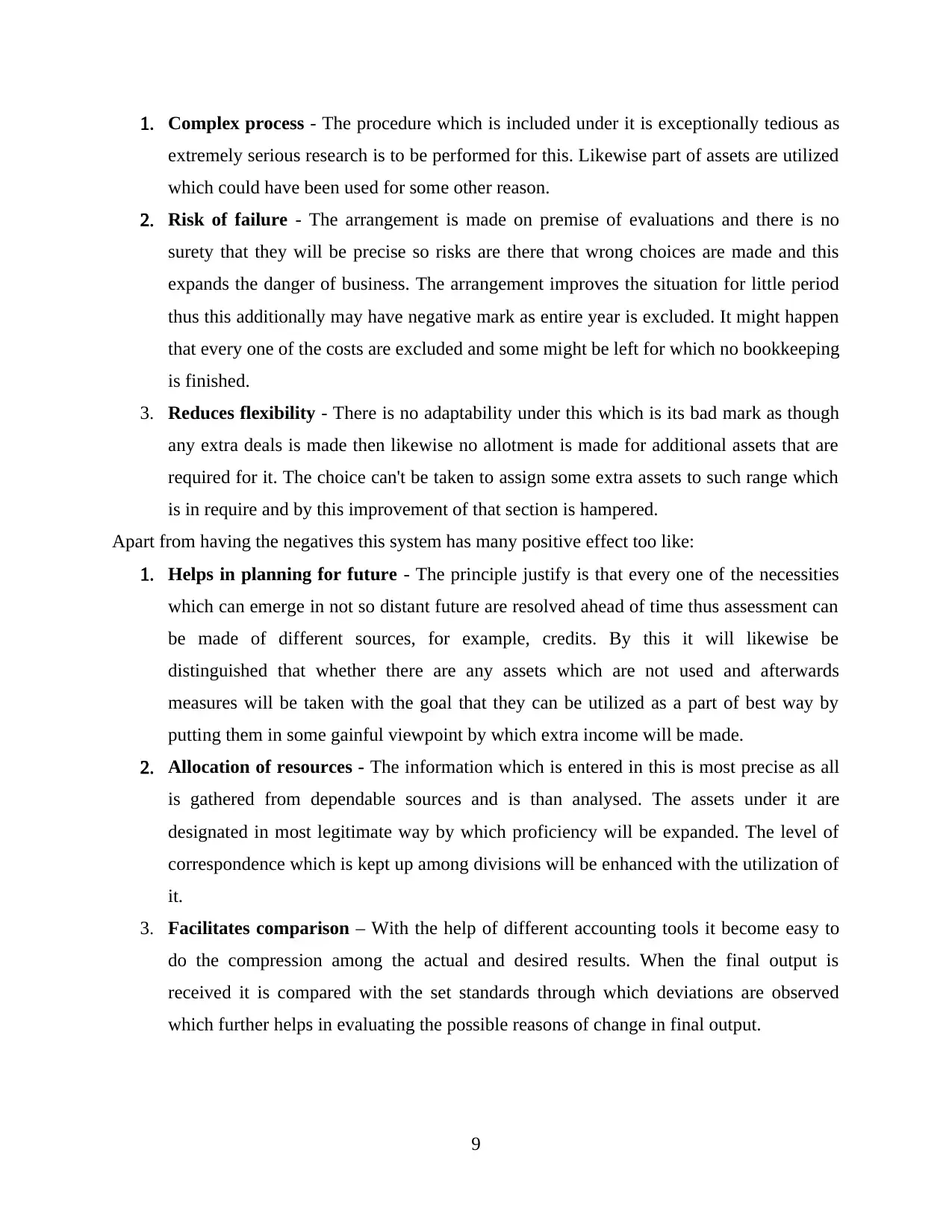
1. Complex process - The procedure which is included under it is exceptionally tedious as
extremely serious research is to be performed for this. Likewise part of assets are utilized
which could have been used for some other reason.
2. Risk of failure - The arrangement is made on premise of evaluations and there is no
surety that they will be precise so risks are there that wrong choices are made and this
expands the danger of business. The arrangement improves the situation for little period
thus this additionally may have negative mark as entire year is excluded. It might happen
that every one of the costs are excluded and some might be left for which no bookkeeping
is finished.
3. Reduces flexibility - There is no adaptability under this which is its bad mark as though
any extra deals is made then likewise no allotment is made for additional assets that are
required for it. The choice can't be taken to assign some extra assets to such range which
is in require and by this improvement of that section is hampered.
Apart from having the negatives this system has many positive effect too like:
1. Helps in planning for future - The principle justify is that every one of the necessities
which can emerge in not so distant future are resolved ahead of time thus assessment can
be made of different sources, for example, credits. By this it will likewise be
distinguished that whether there are any assets which are not used and afterwards
measures will be taken with the goal that they can be utilized as a part of best way by
putting them in some gainful viewpoint by which extra income will be made.
2. Allocation of resources - The information which is entered in this is most precise as all
is gathered from dependable sources and is than analysed. The assets under it are
designated in most legitimate way by which proficiency will be expanded. The level of
correspondence which is kept up among divisions will be enhanced with the utilization of
it.
3. Facilitates comparison – With the help of different accounting tools it become easy to
do the compression among the actual and desired results. When the final output is
received it is compared with the set standards through which deviations are observed
which further helps in evaluating the possible reasons of change in final output.
9
extremely serious research is to be performed for this. Likewise part of assets are utilized
which could have been used for some other reason.
2. Risk of failure - The arrangement is made on premise of evaluations and there is no
surety that they will be precise so risks are there that wrong choices are made and this
expands the danger of business. The arrangement improves the situation for little period
thus this additionally may have negative mark as entire year is excluded. It might happen
that every one of the costs are excluded and some might be left for which no bookkeeping
is finished.
3. Reduces flexibility - There is no adaptability under this which is its bad mark as though
any extra deals is made then likewise no allotment is made for additional assets that are
required for it. The choice can't be taken to assign some extra assets to such range which
is in require and by this improvement of that section is hampered.
Apart from having the negatives this system has many positive effect too like:
1. Helps in planning for future - The principle justify is that every one of the necessities
which can emerge in not so distant future are resolved ahead of time thus assessment can
be made of different sources, for example, credits. By this it will likewise be
distinguished that whether there are any assets which are not used and afterwards
measures will be taken with the goal that they can be utilized as a part of best way by
putting them in some gainful viewpoint by which extra income will be made.
2. Allocation of resources - The information which is entered in this is most precise as all
is gathered from dependable sources and is than analysed. The assets under it are
designated in most legitimate way by which proficiency will be expanded. The level of
correspondence which is kept up among divisions will be enhanced with the utilization of
it.
3. Facilitates comparison – With the help of different accounting tools it become easy to
do the compression among the actual and desired results. When the final output is
received it is compared with the set standards through which deviations are observed
which further helps in evaluating the possible reasons of change in final output.
9
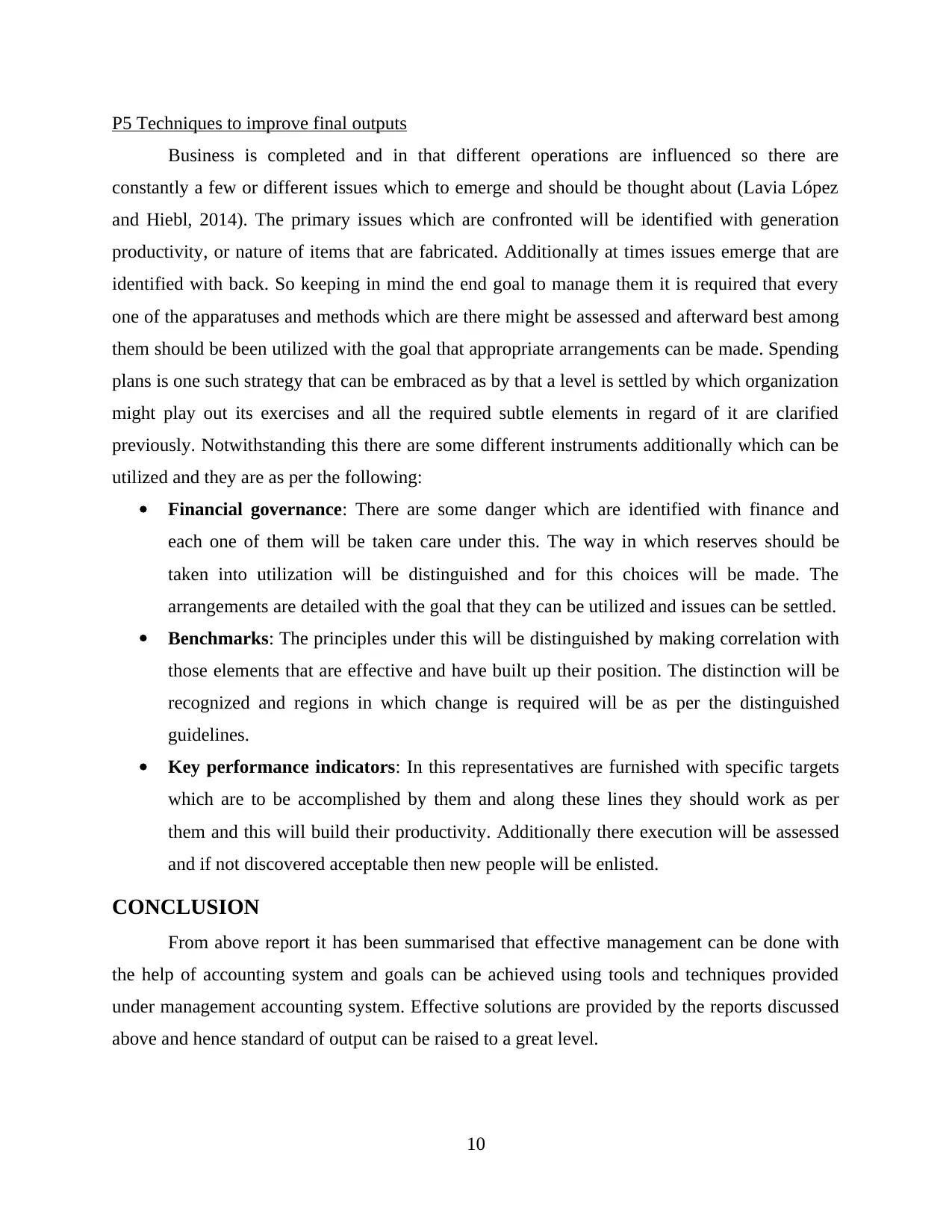
P5 Techniques to improve final outputs
Business is completed and in that different operations are influenced so there are
constantly a few or different issues which to emerge and should be thought about (Lavia López
and Hiebl, 2014). The primary issues which are confronted will be identified with generation
productivity, or nature of items that are fabricated. Additionally at times issues emerge that are
identified with back. So keeping in mind the end goal to manage them it is required that every
one of the apparatuses and methods which are there might be assessed and afterward best among
them should be been utilized with the goal that appropriate arrangements can be made. Spending
plans is one such strategy that can be embraced as by that a level is settled by which organization
might play out its exercises and all the required subtle elements in regard of it are clarified
previously. Notwithstanding this there are some different instruments additionally which can be
utilized and they are as per the following:
Financial governance: There are some danger which are identified with finance and
each one of them will be taken care under this. The way in which reserves should be
taken into utilization will be distinguished and for this choices will be made. The
arrangements are detailed with the goal that they can be utilized and issues can be settled.
Benchmarks: The principles under this will be distinguished by making correlation with
those elements that are effective and have built up their position. The distinction will be
recognized and regions in which change is required will be as per the distinguished
guidelines.
Key performance indicators: In this representatives are furnished with specific targets
which are to be accomplished by them and along these lines they should work as per
them and this will build their productivity. Additionally there execution will be assessed
and if not discovered acceptable then new people will be enlisted.
CONCLUSION
From above report it has been summarised that effective management can be done with
the help of accounting system and goals can be achieved using tools and techniques provided
under management accounting system. Effective solutions are provided by the reports discussed
above and hence standard of output can be raised to a great level.
10
Business is completed and in that different operations are influenced so there are
constantly a few or different issues which to emerge and should be thought about (Lavia López
and Hiebl, 2014). The primary issues which are confronted will be identified with generation
productivity, or nature of items that are fabricated. Additionally at times issues emerge that are
identified with back. So keeping in mind the end goal to manage them it is required that every
one of the apparatuses and methods which are there might be assessed and afterward best among
them should be been utilized with the goal that appropriate arrangements can be made. Spending
plans is one such strategy that can be embraced as by that a level is settled by which organization
might play out its exercises and all the required subtle elements in regard of it are clarified
previously. Notwithstanding this there are some different instruments additionally which can be
utilized and they are as per the following:
Financial governance: There are some danger which are identified with finance and
each one of them will be taken care under this. The way in which reserves should be
taken into utilization will be distinguished and for this choices will be made. The
arrangements are detailed with the goal that they can be utilized and issues can be settled.
Benchmarks: The principles under this will be distinguished by making correlation with
those elements that are effective and have built up their position. The distinction will be
recognized and regions in which change is required will be as per the distinguished
guidelines.
Key performance indicators: In this representatives are furnished with specific targets
which are to be accomplished by them and along these lines they should work as per
them and this will build their productivity. Additionally there execution will be assessed
and if not discovered acceptable then new people will be enlisted.
CONCLUSION
From above report it has been summarised that effective management can be done with
the help of accounting system and goals can be achieved using tools and techniques provided
under management accounting system. Effective solutions are provided by the reports discussed
above and hence standard of output can be raised to a great level.
10
⊘ This is a preview!⊘
Do you want full access?
Subscribe today to unlock all pages.

Trusted by 1+ million students worldwide
1 out of 14
Related Documents
Your All-in-One AI-Powered Toolkit for Academic Success.
+13062052269
info@desklib.com
Available 24*7 on WhatsApp / Email
![[object Object]](/_next/static/media/star-bottom.7253800d.svg)
Unlock your academic potential
Copyright © 2020–2025 A2Z Services. All Rights Reserved. Developed and managed by ZUCOL.





